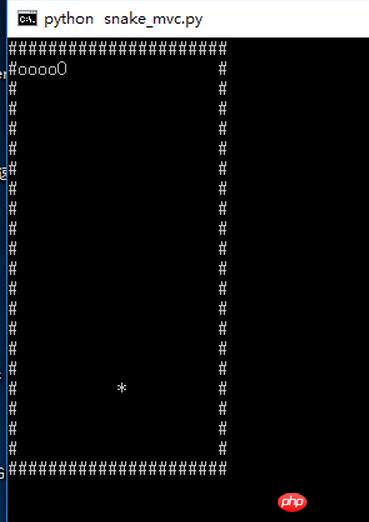Python으로 뱀 게임을 작성하기 위한 코드 예제
- Y2J원래의
- 2017-04-27 09:24:318676검색
이 글은 주로 파이썬 스네이크 게임의 작성 코드를 자세하게 소개하고 있습니다. 관심 있는 친구들이 참고하면 좋을 것 같습니다.
요즘 파이썬을 배우고 있는데 연습해 보겠습니다. 명령줄 위의 스네이크는 보통 C 연습 프로젝트인데 한동안 다른 것을 찾을 수 없어서 간단한 문법 연습을 위해 먼저 스네이크를 만들어봤습니다.
파이썬에서는 키보드를 모니터링하기가 번거롭고 C언어에는 kbhit()이 없기 때문에 이 욕심쟁이 뱀이 스스로 움직이지 않게 되는 효과는 다음과 같습니다.

요구 사항: #을 사용하여 테두리를 나타내고, *를 사용하여 음식을 나타내고, o를 사용하여 뱀의 몸을 나타내고, O를 사용하여 뱀의 머리를 나타내고, wsad를 사용하여 이동합니다.
Python 버전: 3.6.1
시스템 환경: Win10
카테고리:
보드: 게임 영역인 체스보드
뱀 : 탐욕스러운 뱀, 각 몸을 기록하여 뱀의 상태를 기록하려면 클릭하세요
게임 : 게임 카테고리
원래는 음식 카테고리를 원했는데 음식 좌표는 하나만 있으면 됩니다 그리고 새로운 음식이 있기 때문에 단순히 목록을 사용하여 좌표를 저장하는 것은 논리적으로 큰 문제가 아닙니다.
소스 코드:
# Write By Guobao
# 2017/4//7
#
# 贪吃蛇
# 用#做边界,*做食物,o做身体和头部
# python 3.6.1
import copy
import random
import os
import msvcrt
# the board class, used to put everything
class board:
__points =[]
def __init__(self):
self.__points.clear()
for i in range(22):
line = []
if i == 0 or i == 21:
for j in range(22):
line.append('#')
else:
line.append('#')
for j in range(20):
line.append(' ')
line.append('#')
self.__points.append(line)
def getPoint(self, location):
return self.__points[location[0]][location[1]]
def clear(self):
self.__points.clear()
for i in range(22):
line = []
if i == 0 or i == 21:
for j in range(22):
line.append('#')
else:
line.append('#')
for j in range(20):
line.append(' ')
line.append('#')
self.__points.append(line)
def put_snake(self, snake_locations):
# clear the board
self.clear()
# put the snake points
for x in snake_locations:
self.__points[x[0]][x[1]] = 'o'
# the head
x = snake_locations[len(snake_locations) - 1]
self.__points[x[0]][x[1]] = 'O'
def put_food(self, food_location):
self.__points[food_location[0]][food_location[1]] = '*'
def show(self):
os.system("cls")
for i in range(22):
for j in range(22):
print(self.__points[i][j], end='')
print()
# the snake class
class snake:
__points = []
def __init__(self):
for i in range(1, 6):
self.__points.append([1, i])
def getPoints(self):
return self.__points
# move to the next position
# give the next head
def move(self, next_head):
self.__points.pop(0)
self.__points.append(next_head)
# eat the food
# give the next head
def eat(self, next_head):
self.__points.append(next_head)
# calc the next state
# and return the direction
def next_head(self, direction='default'):
# need to change the value, so copy it
head = copy.deepcopy(self.__points[len(self.__points) - 1])
# calc the "default" direction
if direction == 'default':
neck = self.__points[len(self.__points) - 2]
if neck[0] > head[0]:
direction = 'up'
elif neck[0] < head[0]:
direction = 'down'
elif neck[1] > head[1]:
direction = 'left'
elif neck[1] < head[1]:
direction = 'right'
if direction == 'up':
head[0] = head[0] - 1
elif direction == 'down':
head[0] = head[0] + 1
elif direction == 'left':
head[1] = head[1] - 1
elif direction == 'right':
head[1] = head[1] + 1
return head
# the game
class game:
board = board()
snake = snake()
food = []
count = 0
def __init__(self):
self.new_food()
self.board.clear()
self.board.put_snake(self.snake.getPoints())
self.board.put_food(self.food)
def new_food(self):
while 1:
line = random.randint(1, 20)
column = random.randint(1, 20)
if self.board.getPoint([column, line]) == ' ':
self.food = [column, line]
return
def show(self):
self.board.clear()
self.board.put_snake(self.snake.getPoints())
self.board.put_food(self.food)
self.board.show()
def run(self):
self.board.show()
# the 'w a s d' are the directions
operation_dict = {b'w': 'up', b'W': 'up', b's': 'down', b'S': 'down', b'a': 'left', b'A': 'left', b'd': 'right', b'D': 'right'}
op = msvcrt.getch()
while op != b'q':
if op not in operation_dict:
op = msvcrt.getch()
else:
new_head = self.snake.next_head(operation_dict[op])
# get the food
if self.board.getPoint(new_head) == '*':
self.snake.eat(new_head)
self.count = self.count + 1
if self.count >= 15:
self.show()
print("Good Job")
break
else:
self.new_food()
self.show()
# 反向一Q日神仙
elif new_head == self.snake.getPoints()[len(self.snake.getPoints()) - 2]:
pass
# rush the wall
elif self.board.getPoint(new_head) == '#' or self.board.getPoint(new_head) == 'o':
print('GG')
break
# normal move
else:
self.snake.move(new_head)
self.show()
op = msvcrt.getch()
game().run()참고:
1. Python에는 Switch Case 문이 없으므로 Dirt를 사용하여 구현할 수 있습니다.
2. Python의 = 기호는 복사, 복사 참조, 심층입니다. copy는
3을 구현하기 위해 copy의 deepcopy() 함수를 사용해야 합니다. 멤버 함수 내에서도 멤버 변수에 액세스하려면 self를 사용해야 하는데, 이는 C++ 및 JAVA와 매우 다릅니다
위 내용은 Python으로 뱀 게임을 작성하기 위한 코드 예제의 상세 내용입니다. 자세한 내용은 PHP 중국어 웹사이트의 기타 관련 기사를 참조하세요!

